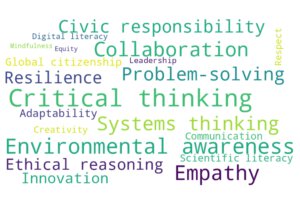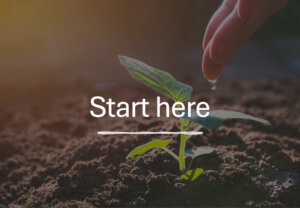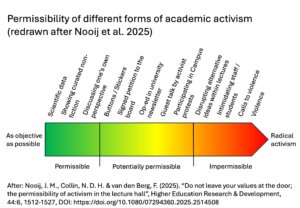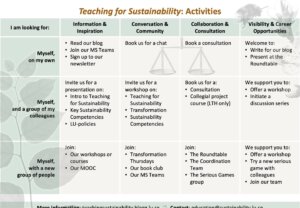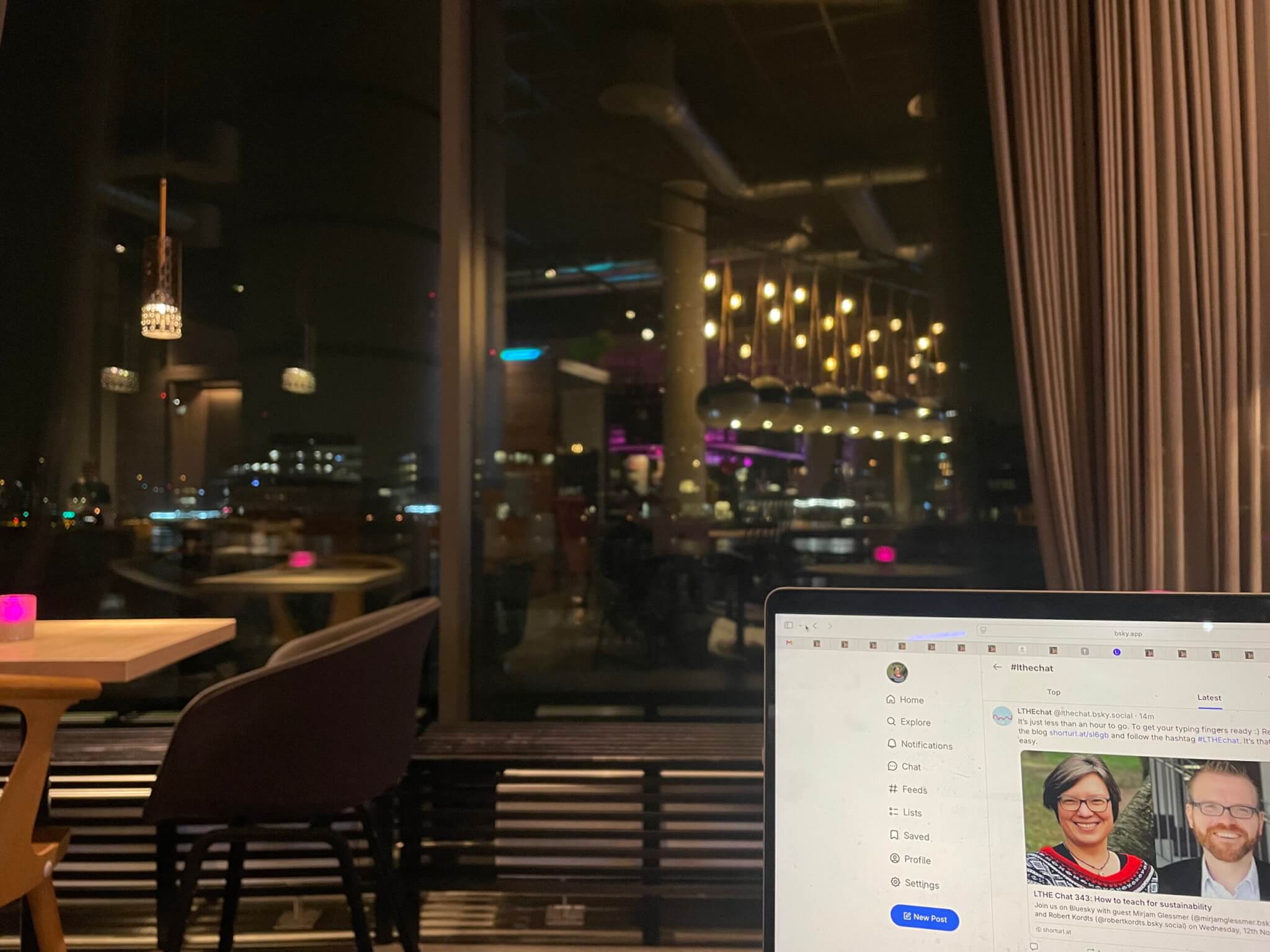
LTHE Chat 343: How to teach for sustainability. Our blog post and summary of the discussion
On Wednesday, Robert Kordts (awesome colleague and my co-teacher on the last Teaching for Sustainability academic development course) and myself tried a new-to-us format: A “Learning and Teaching in Higher Education” chat on Bluesky! The format is simple: We wrote a blog post (see here on their website, or read on below) and prepared six questions that were posted spread out over an hour, and then we waited how people reacted to it, and responded!
I am posting the blog post below, and then the questions with links to the responses on Bluesky. It was fun and inspiring and intense and a little overwhelming, but I would definitely do it again!
Here is the blogpost:
The title of this blog post, “How to teach for sustainability”, might sound like we have the answer, but to be clear right away – we do not. But we invite you to address this, the biggest challenge that we as teachers and academic developers are facing, with us, and to hopefully come a little bit closer to answering the question how we can learn – and teach – for a sustainable world.
In this blog post, we suggest different ways to think about teaching for sustainability. We acknowledge that most teachers are not experts on sustainability (which, arguably, do not exist, since sustainability is a wicked problem and solutions need to be co-created locally and globally), that we are all pressed for time, that there are many other tasks and challenges competing for our attention. Given all that, where does one start?
In January 2025, Kyle Bartlett posted on bluesky about five forms to think about teaching for sustainability in music education. We took this framework and translated it first into Engineering Education but have since used it in higher education more generally because we find it to be a helpful tool to explore different facets of what is important to consider. In the following, we will thus explore what it might mean to teach about, with, in, through, and for sustainability.
Teaching about sustainability
Teachers starting out on their sustainability journey often begin with teaching *about* sustainability, i.e. teaching about general concepts related to sustainability, for example about the UN Sustainable Development Goals, about climate change, about planetary boundaries. This is not surprising, since most of the resources that are easily available to use or adapt, especially by obvious authorities on the topic like UN bodies and national governments, are designed for the broadest audiences possible, and therefore very general.
While it is important that students have a general understanding of those concepts, the danger is that many teachers are implementing very similar, introductory content so that sustainability, in the students’ perception, might become narrow, repetitive, boring, and disconnected from the course’s or program’s content and therefore not relevant to their studies and their lives. There is also the danger of token discussions when sustainability might be seen as sufficiently addressed after basic concepts have been clarified.
Teaching with sustainability
Another common approach is to teach *with* sustainability: including examples of sustainability applications within the discipline (for example solar panels or carbon neutral bridges in engineering, international negotiations in law, the effect of heat waves on humans in medicine, reimagining monetary systems in economy, and many more). It is very important that students think about sustainability in the context of their subjects! However, examples alone are not enough. If we want to address the bigger picture, it is necessary to connect sustainability and teaching in other ways. We want to challenge teachers to also consider teaching *in*, *through*, and *for* sustainability.
Teaching in sustainability
Teaching *in* sustainability positions the discipline as part of a sustainable world. This means remembering that we are acting as role models for professional and personal responsibility (whether we want to or not), so we should explicitly talk about sustainability as an integrated part of our own and the students’ future professional role. In their article “Do not leave your values at the door”, Nooij et al. (2025) remind us that inaction isn’t neutral, and that what is perceived as activism and permissible depends a lot on whether people agree with the stance, and on whether people are aware that they are not objective themselves.
Teaching in sustainability can also include teaching about how to cope with climate anxiety – sharing our own experiences and emotions, holding space for conversations with students, and pointing to resources. Eriksson et al. (2022) share ways how one might do this.
Teaching through sustainability
Teaching *through* sustainability is about practicing today how we hope to live and work together in a sustainable world. This is not something that we can expect to just magically happen; it needs practicing – both in the sense of repeatedly doing it to get better, and as being in the habit of doing it. Teaching through sustainability means using sustainable pedagogies which are both transformative and emancipatory and facilitate an inclusive and equitable learning environment. A great place to start is to consider that “the magic of inclusion: transformative action for sustainability education” by Ahlberg et al. (2025), or more practically the “Liberating Structures” and Tanner (2013)’s “teaching strategies to promote student engagement and cultivate classroom equity”.
Teaching for sustainability
Teaching *for* sustainability means inspiring action for sustainable development. It is not enough to have knowledge and understanding, and competencies and skills. We also need to develop our judgement and approach – and foster the will and the drive to use our freedom to do good things in the world. How can we empower students to take action towards a sustainable world?
The literature has generally converged on what competencies students will need to learn to meet those challenges, and Redman & Wiek (2021) suggest a framework which puts the key competencies in sustainability (the four interconnected planning competencies systems-, futures-, values-, and strategies thinking) as well as implementation and integration competence in the context of other professional, disciplinary, and general competencies. While some of these competencies can be practiced independently, their integration – and practicing them in an integrated way – is key (and thus even highlighted as its own competence). How can we ensure our students have the opportunity to learn this?
References
Ahlberg, S., Kennon, P., & Rončević, K. (2025). The Magic of Inclusion: Transformative Action for Sustainability Education. All means all!-OpenTextbook for diversity in education. https://book.all-means-all.education/
Eriksson, E., Peters, A. K., Pargman, D., Hedin, B., Laurell-Thorslund, M., & Sjöö, S. (2022, June). Addressing students’ eco-anxiety when teaching sustainability in higher education. In 2022 International Conference on ICT for Sustainability (ICT4S) (pp. 88-98). IEEE. DOI: https://doi.org/10.1109/ICT4S55073.2022.00020
Nooij, J. M., Collin, N. D. H. & van den Berg, F. (2025). “Do not leave your values at the door; the permissibility of activism in the lecture hall”, Higher Education Research & Development, 44:6, 1512-1527, DOI: https://doi.org/10.1080/07294360.2025.2514508
Redman, A., & Wiek, A. (2021, November). Competencies for advancing transformations towards sustainability. In Frontiers in Education (Vol. 6, p. 785163). Frontiers Media SA. DOI: https://doi.org/10.3389/feduc.2021.785163
Tanner, K. D. (2013). Structure matters: Twenty-one teaching strategies to promote student engagement and cultivate classroom equity. CBE—Life Sciences Education, 12(3), 322-331. DOI: https://doi.org/10.1187/cbe.13-06-0115
6 questions
The links at “Q1”, “Q2” etc bring you to the questions on Bluesky, where you can also see all the responses (no login required!). In a nutshell: People really stress the importance of finding community!
Q1: What do you think is the most important knowledge, skill, attitude our students need to learn to contribute to a sustainable world?
I must admit, this is a really difficult question and maybe a bit mean to start with, since for myself the answer depends a bit on the mood of the day (but of course it also depends on which students we think of). For me, compassion and care stands out as what I feel is lacking in the world, and there were many responses in that direction, as well as about a sense of proportion — for example showing images of the Earth from space to make the point that “this is all we are, all we have, and all of our futures, and we’re all in it together“. But also learning to cope with uncertainty, which I agree is super important.
Q2: What would you recommend to someone who wants to implement sustainability in their teaching but does not know where to start? What resources, networks, mindsets?
This question produced a lot of concrete advice, for example a Climate Venn diagram where climate action lies in the intersection of “What needs doing?”, “What brings you joy?”, and “What are you good at?”, but also links to frameworks and the advice to really focus on finding connections, for example through a coffee with someone who is a couple of steps ahead (what we in my courses often call “inspirational fika”).
Q3: If you had a minute, a morning, a month to spend on preparing new teaching for sustainability, where would you put your focus?
Here, what I enjoyed most was seeing that the framework made sense to people. It was meant to convey the idea that you can start small and that moving is better than not moving, so it was great to see that someone, in response to the last question (of what they are taking away from the chat) responded “If something seems overwhelming, consider what I can do in a minute or a morning and stop focusing on needing a month to do the idea justice. Chip away. Be iterative.” But there were also a lot concrete suggestions, for example to read more about climate emotions; go check them out on Bluesky!
Q4: How do you balance authenticity, professionality, activism, departmental and student expectations, …? In your work, in your life?
This part of the chat felt really nice, especially seeing that I myself am currently on intense work travel and that the chat happened at 9 pm my time at the end of one intense conference before the next one was about to start the next morning: There were lots of really kind and supportive messages about staying true to yourelf, finding your community that supports you in it, and going out into nature when everything gets too overwhelming.
Q5: What resources or support would you need to (more) confidently teach for sustainability? Where might you find them or who might provide them?
Interestingly, here the consensus seemed to be that resources aren’t really the issue, finding community is!
Q6: What action do you want to commit to inspired by today’s #LTHEChat?
Again, connecting with others seems to be a big topic, but also the recognition that you can start small (that I mention already above). Seems like the “minute, morning, month” framing is promising to explore further!
And that’s it for now, I still need to explore all the linked resources in more detail (which is what I put on my to-do list after that chat…). But it was a great experience and I am definitely going to do it again. But then with a better technical setup and also probably with responses prepared for the questions I am asking myself, although it was nice to not be the first to jump in to respond and rather see what happens…
Featured image: Sitting in a hotel lobby with sea view (slightly obstructed by reflections in the window), preparing for the LTHEChat…
